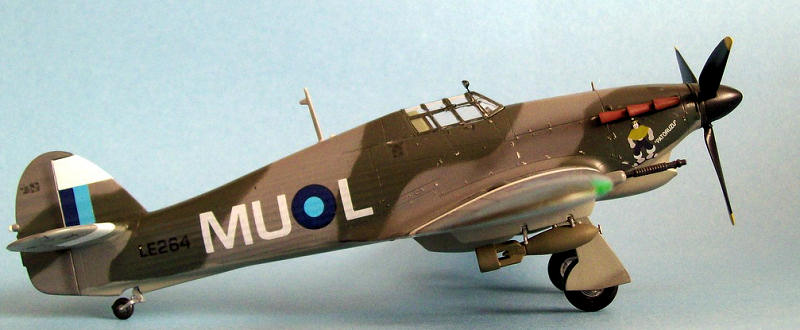
Hobbycraft 1/48 Hurricane IIc
| KIT #: | HC 1533 |
| PRICE: | CAN$30.00 |
| DECALS: | options |
| REVIEWER: | Pablo Calcaterra |
| NOTES: |
Several parts “stolen” from Hasegawa’s Hurricane Mk IIB (JT66) and
|

| HISTORY |
Ricardo Campbell Lindsell was born
in Buenos Aires,
Months after war broke out,
Ricardo (or Richard) traveled to
In December they all joined the
RCAF and Ricardo was trained close to where I leave, in Mount Hope, Ontario
(EFTS 10), then moving to Brantford, Nova Scotia and finally when training was
over, he was sent to England by ship in May 1941.
Ricardo was transferred to OTU 13
were he trained to fly Blenheims. On 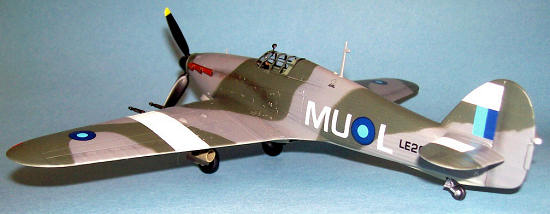 circuses he was in one of the Blenheims that participated in the mission that dropped new legs for Douglas
Bader (along with some bombs!) who was then a POW.
circuses he was in one of the Blenheims that participated in the mission that dropped new legs for Douglas
Bader (along with some bombs!) who was then a POW.
During another mission, he led 39
Hurricanes that took off from HMS
At the end of February he became
Squadron Leader and got married with a WAAF. And at the same time, he was
assigned to 110 Sqn in the
In all, he had completed: Circus
operations (France, occupied territory) 3 hours, shipping sweeps (Dutch coast,
etc.) 12 hours 25 minutes, night intruder sorties to Holland 2 hours 50 minutes,
Scharnhorst and Gneisenau ops (12 Feb 42) 3 hours 15 minutes.
Leading 110 Sqn Blenheims Ricardo
fought some heavy storms and managed to land in
From there they rested for three
months at
In August they started training in
Hurricanes at 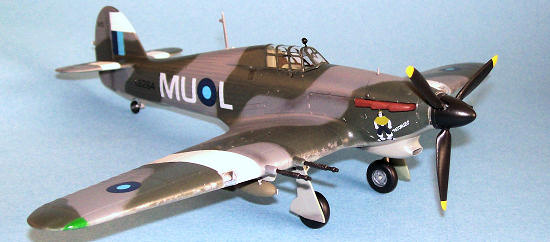 Argentine cartoon Patoruzu painted on the
right side of the nose. Patoruzu was a very resourceful native that fought
injustice with his great heart and simple weapons.
Argentine cartoon Patoruzu painted on the
right side of the nose. Patoruzu was a very resourceful native that fought
injustice with his great heart and simple weapons.
January 1944 saw the Hurribombers
starting their ground attack missions.
With two 250 lb bombs and their 4 x 20 mm guns, they created havoc in the
Japanese positions.
I will describe some of incidents
worth mentioning:
On March 8th, 1944 4
sections of 3 Hurricanes flying in “V” were flying and awaiting orders to bomb
Mayu. Suddenly, the plane flown by another Argentine (Frankie Hall, who had
flown in the Battle of Britain) started to dive with no apparent damage. Ricardo
shouted: ”Frankie, get out, get out!” but to no avail. Plane and pilot crashed
closed to some huts and left a huge crater. Years later, when discussing this
incident with fellow pilots “Chota” Bambridge and Tony Justsum, they reminded
Lindsell that after Hall had crashed he told his pilots to open their hoods in
order to prevent any potential build up of carbon monoxide, assuming that that
could have been the reason why Hall had not answered and crashed.
The bridge at Ukhrul was a vital
target as thru this the Japanese were reinforcing their Army. It was made of
wood, bamboo and other materials taken from the jungle. In May Lindsell and his
wingman Shephard attacked it and caught some soldiers crossing it by surprise.
Thought they tried to fight back, the combination of 20 mm guns and bombs made
short work of the enemies. The bridge blew up.
During those days, 60 Sqn along
with 113 and 34 Sqn were giving close support to the Chindits. There was a
bunker in a hill from where the Japanese were giving a hard time to the British
troops. 60 Sqn was called and they attacked while they were being fired at from
the bunker. The Japanese never ceased to fire even when they were being
attacked. Some bombs hit the bunker and the troops started to climb again but
the Japanese opened fired again and cut down several British. The Hurribombers
were called again. All bombs were dropped on the bunker and when the Chindits
arrived, all the Japanese were dead.
In Kohima the Hurricanes of 60Sqn
fought with great distinction, destroying bridges, bunkers, fuel depots and even
a radar site that was heavily protected by AA guns.
In June 1944 Ricardo left his 60
Sqn and after a trip by ship he arrived in Liverpool very tired. In London he
met his wife after two and a half years. His leaders wrote of him:
”Squadron
Leader Lindsell has been responsible for the training and extreme efficiency of
his squadron on operations after re-equipping from Blenheim aircraft to
Hurricane bombers. Through his energy and leadership his squadron carried out
728 sorties from the 1st April to 2nd May 1944, during which time many
congratulatory signals were received from the forward army units, on the
accuracy of their bombing, who were on occasions only
100 feet away from the
target. This officer has shown exceptional k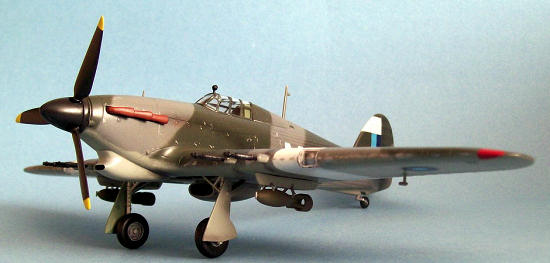 eenness for operations and his
powers of command, leadership and devotion to duty are outstanding”
eenness for operations and his
powers of command, leadership and devotion to duty are outstanding”
Commanding Officer of No.189 Wing (W/C P.K. Devitt) 5 June 1944
”The manner in which Squadron Leader Lindsell converted his squadron to a
remarkably reliable and accurate Hurri-bomber squadron in a very short space of
time on joining this Group was worthy of the highest recognition. His personal
keenness and powers of leadership have made the squadron into a really good one,
both from the point of view of operational results and aircraft serviceability.
He has personally led the squadron on many extremely dangerous and successful
sorties. Strongly recommended for the award of the Distinguished Flying Cross.”
Air Commodore commanding No.221
Group (21 June 1944)
In September 1944 he was given the
Summary of his missions in the
India, No.60 Squadron, Arakan
Front (Blenheim IVs), March to May 1943
Close support-bombing operations 16 hours 40 minutes
Long-range strategic bombing (airfields, etc.) 9 hours 35 minutes
Offensive bomber and road reconnaissance ops. 3 hours 35 minutes
India, No.60 Squadron (Hurricane IIC aircraft), November 1943 to May 1944
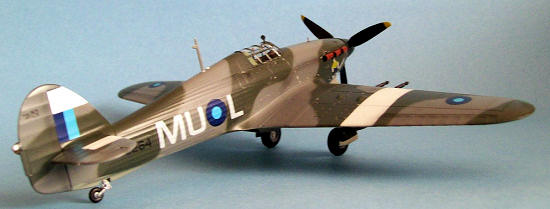 Scrambles and searches 7 hours 15 minutes
Scrambles and searches 7 hours 15 minutes
Bomber and transport escorts 40 hours 15 minutes
Day long-range rhubarbs 6 hours 55 minutes
Night long-range rhubarbs 3 hours 35 minutes
A.S.C. Strafing (Arakan) 3 hours 5 minutes
A.S.C. Hurri-bombing and strafing, Imphal and Chindwin 69 hours 40 minutes
TOTAL: 243 hours 35 minutes
In January 1945 he was sent to
Canada were he left the RCAF. In May 1945 he returned to Argentina by plane and
in September he returned to his old work at Alpargatas. He worked there for
almost 2 years and then returned to the UK where he worked for 9 years. Then he
went to live in 1955 to Venezuela, in 1967 back to the UK, and then Spain.
Ricardo Campbell Lindsell died in
England in October 1988. Out of his group of 16 volunteers, only 3 survived the
war (among them Malcolm Benitz who was brother in law of “Pancho” le Bas,
another Argentine who flew in Malta and had a long career in the RAF after the
war)
| THE KIT |
This is the well-known and “old” Hobbycraft kit. Simple, with several panels missing or wrong, but makes a decent Hurricane Mk IIC. No matter what HC claims and sells, you cannot make a IIB or IID unless you do some dramatic re scribing of panel lines to represent the access to the machine guns. From my point of view, you can only make an IIC.
| CONSTRUCTION |
The interior is very
Spartan but
also you won’t be able to see a lot thru the canopy. I painted all the interior
of the cockpit, radiator and wheel wells in RAF interior green (MM Acryl 4850).
Details were picked up using a dry brush with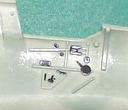 aluminium piant. Knobs in black
here and there. The instrument panel is black with drops of Future in the dials.
aluminium piant. Knobs in black
here and there. The instrument panel is black with drops of Future in the dials.
The seat was given a hand of
Future with a brush and when it was dry I added some seatbelts I had left aside
from Tamiya’s Beaufighter.
Putting together the main
subcomponents was painless and fit is quite good. The most important defect is
that there are several panel lines incomplete (present on the top of the wings
but missing on the bottom, as an example the border of attack). Others, to name
a few, include the ones around the ejection holes for the guns (which are also
inexistent!) and the three
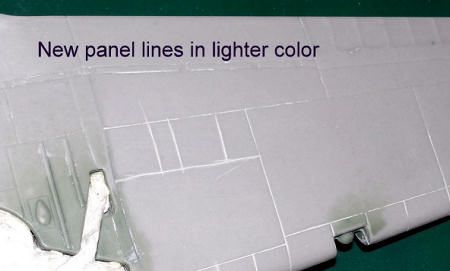 panels after the radiator under the fuselage.
The access
doors to the guns are too long so I covered them with putty and re scribed them.
panels after the radiator under the fuselage.
The access
doors to the guns are too long so I covered them with putty and re scribed them.
There was a little gap between the fuselage and the wings union. Like always, when it comes to such small places and when I run the risk of loosing details when sanding, I use acrylic base. It is a white paste that I apply with a brush, let it dry for no more than 2 minutes and then I remove (the excess) using a damp cloth across the line (not following the panel or you will loose the base that got in the gap).
I glued the horizontal tail
surfaces and the guns. The wheel wells were masked along with the cockpit and
the radiator.
| COLORS & MARKINGS |
All panel lines were pre shaded in
black. Then the plane was given a coat of MM Acryl 4759 all over. This would
give a good base for the white ID bands and also check for potential defects in
my panels.
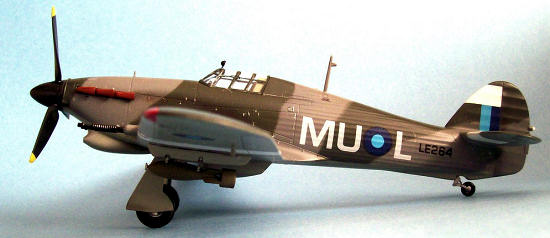 With white then, after the grey
was dry, I painted the white ID (MM Acryl 4696) bands typical of the
With white then, after the grey
was dry, I painted the white ID (MM Acryl 4696) bands typical of the
With the ID bands and bottom
surfaces masked with paper and Tamiya tape (the separation from the top was made
up with rolls of blue tac), I pre shaded again several areas and then painted
the top surface with RAF dark green (MM Acryl AN00625). Then I masked the dark
green and added the last colour, this being dark grey (MM Acryl 4755)
With sanded black/brown pastel and
a brush I made the stains for the engine exhausts, moveable surfaces, cannons,
ejection holes in the wings (where I was going to place the holes made with
decals), oil stains under the fuselage. With a sharpened pencil I highlighted
the moveable surfaces.
 A silver pen was used to “chip”
some paint here and there.
A silver pen was used to “chip”
some paint here and there.
Decals:
Several layers of Future sealed
the colours and the stains. By then I had added the main landing gear.
Decals from Condor Decals are, in
my opinion, oversized. If you take the actual size of the tail bands (azure and
blue), decals are 3 mm too large. Main letters are also too large when compared
to the pictures I have seen. Probably the 1/72nd would have worked
better?
Anyway, I trimmed the decals for
the bands on the tail. I added all the rest of the decals from Condor. The white
part of the feather above Patoruzu’s head is missing so I painted it carefully
with white.
Now, the HC kit has no stencils at all. I scanned them from other kits and printed in clear decal paper. Regarding the guns ejection holes, I took them from some scale planes, reduced them to size required for my model, and printed also printed them in clear decal paper. Once these homemade decals were printed, I covered them with a carefully applied layer of Testor Decal Bonder.
Stencils were applied and the kit
was given a coat of semi gloss varnish.
| FINAL CONSTRUCTION |
At this point, I realized that the
Hasegawa MkIIB Hurricane that I have and will build as Nana Adamson’s
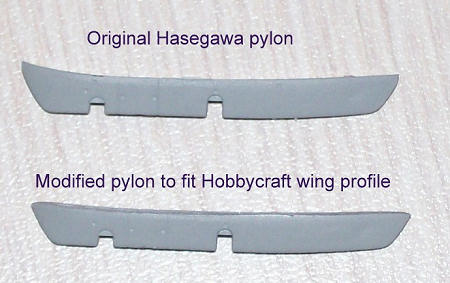
From the Hasegawa MkIa Squadron
Leader I took the not needed pieces: the long propeller spinner for an MkII and
the knuckled tail wheel (the one supplied by HC is for a MkI).
I added the gunsights (reflector
and scratch built bead on top of nose), the hood and windshield and the two
handles outside the hood (made up of black bristles). The light under the
fuselage was taken from the spares (not supplied by HC).
I painted the navigation lights in
red, green and white.
The rear mirror is made of two
parts: photo etched (True Details 48710) painted in chrome silver and the tip of
a bomb for the rounded part. I had to add this part of plastic or the mirror
would have been flat had I used only the photo etched piece.
I added the bombs, cover for main
landing lights that I painted in chrome silver, Pitot tube, exhausts (painted in
rust MM Acryl 4675 and black) and the wheels along with the wheel doors.
The navigation light behind the
cockpit was taken from the spares (Hasegawa’s P-40). I added the antenna mast
and the plane was ready.
| CONCLUSIONS |
Not a very difficult kit. Just take care with the panel lines. Though the Vokes filter is not accurate, overall I believe it represents quite well Lindsell’s “Suertudo”
| REFERENCES |
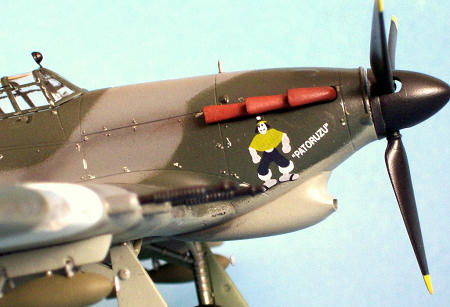 Hawker Hurricane (Richard
Franks)
Hawker Hurricane (Richard
Franks)
“Nacidos con Honor”, Claudio
Meunier, October 2007
Air Force Association of Canada
February 2011
Thanks for your help, Claudio! And
also because you are bringing to light all those unknown stories about the
Argentines that flew with the RAF and RCAF in WWII.
Post script regarding my Spitfire
MkIX flown by Ken Charney:
Claudio Meunier has finally made it possible, and early in 2011 Ken’s remains
will be send back from Andorra to his native Bahia Blanca.
http://modelingmadness.com/reviews/allies/gb/calspit9.htm
If you would like your product reviewed fairly and quickly, please contact me or see other details in the Note to Contributors.